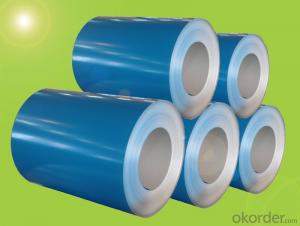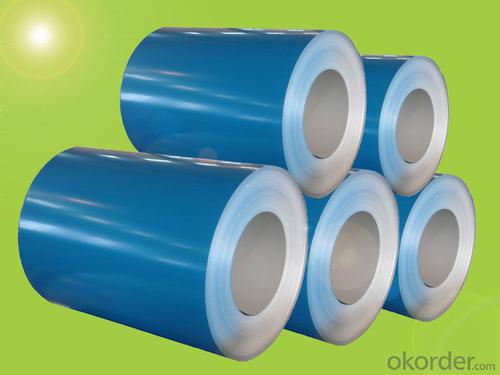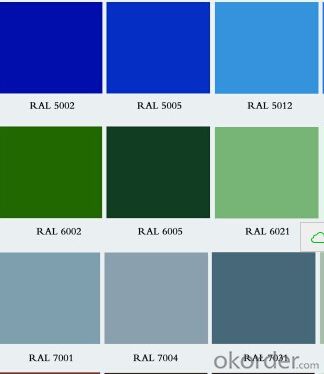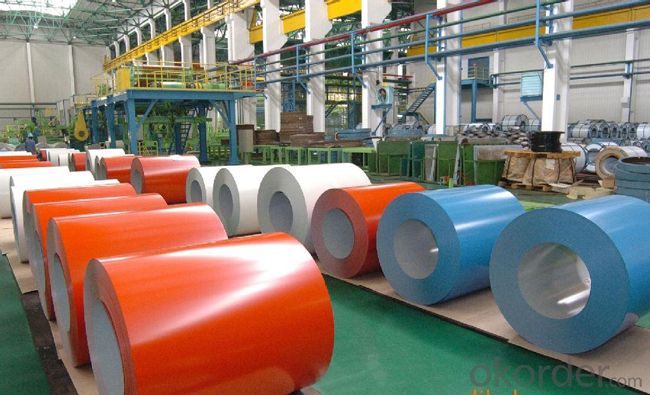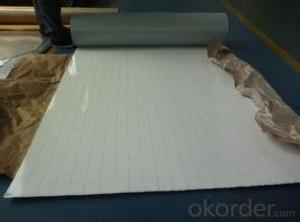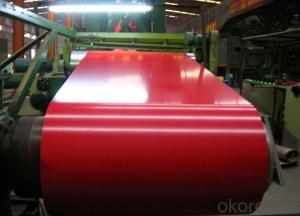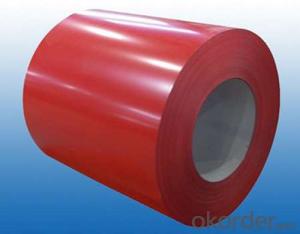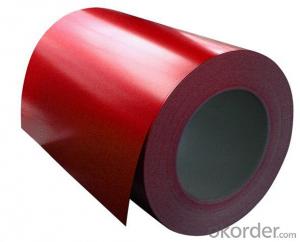Hot Sale Painted Steel Coil
- Loading Port:
- China Main Port
- Payment Terms:
- TT OR LC
- Min Order Qty:
- -
- Supply Capability:
- -
OKorder Service Pledge
OKorder Financial Service
You Might Also Like
Product Features
super weather resistance and durability , also the pattern is capable to bring about plenty of effects of multilayer, parallax and 3D effect.
Application
It is the perfect building material in construction for making steel roofing/suspended ceiling, office partition, Sandwich panel, insulation panel, corrugate sheet, facade wall,rolling doors, T-bar, garage door and shutters etc.
Structure of Cross-section
Items | Thickness | Type | Features |
Protection Film | 50μm | polyethylene | Protecting from scratches and |
Finished Coat | 10μm | PVDF | Protecting printed layer and enhances |
Print | ≦1μm | Ink, Polyester | Various printing patterns,3 colors overprint |
Top Coat | 20μm | Polyester Fluorine | Chemical resistance, formability and |
Primer Coat | 5μm | Polyester | workability, corrosion resistance and |
Chemical Treatment | ≦1μm | Chromate | Good adhesion and corrosion resistance |
Substrate | 0.2-1.2mm | GI.GL.AL | GI.GL,AL |
Chemical Treatment | ≦1μm | Chromate | Good adhesion and corrosion resistance |
Back Coat | 5μm | Epoxy | corrosion resistance and adhesion to the |
- Q: So what's harder gold or steel
- steel. it's used to support skyscrapers lol. gold can be molded easily into jewelry. although both gold and steel are both malleable, steel is harder to shape.
- Q: What are the different types of steel coatings used on coils?
- There are several types of steel coatings used on coils, including galvanized coatings, zinc-nickel coatings, aluminum-zinc coatings, and organic coatings.
- Q: How are steel coils used in the production of steel connectors?
- Steel coils are used in the production of steel connectors as they are formed into specific shapes and sizes, such as plates or bars, which are then cut, bent, and welded to create the connectors. The coils provide a continuous and easily manageable supply of steel material, allowing for efficient and precise manufacturing processes.
- Q: What are the quality standards for steel coil production?
- The quality standards for steel coil production typically include factors such as dimensional accuracy, surface finish, mechanical properties, chemical composition, and adherence to industry-specific standards and specifications. These standards ensure that the steel coils meet the required strength, durability, and performance criteria, and are suitable for various applications in industries like automotive, construction, and manufacturing.
- Q: When I took guitar lessons, I found that the Nylon strings are easier for me, but I love the sound of steel strings. Now, I have my own acoustic guitar, and 2 strings broke off, so I'm getting strings today. I'm not sure if Nylon strings would 'fit' on my guitar, and it's to soft of a noise. But the steel are much better sounding, but it's a little bit harder to push the string down on the fret. Which do you prefer, why?(:
- classical guitar = nylon strings Acoustic/electric = steel strings Firstly i must explain you that fingerstyle playing on guitar is using your nails to play and not the soft spot on the acre of your fingers... Why? Because nails produce a cleaner, better and louder sound while the soft spot Is sloppy and dusty... (very simplistic)The difference with using a pick is that you can use your fingers as 4 different picks instead the one you are using when playing with a pick... Well the reason is that nylon strings aren't supposed to be played with a pick but with fingers (nails in reality as mentioned already) if you want το keep them in good condition for long(the sound they provide is another thing and it's a matter of taste) Steel strings are better for using with a pick... Probably a classical guitarist would easily break or harm his nails while playing on steel strings.... Personaly i like both... Depends on what playing
- Q: What are the factors that determine the price of steel coils?
- There are several factors that determine the price of steel coils. 1. Raw material costs: The cost of raw materials, such as iron ore and coal, which are used in the production of steel, directly affect the price of steel coils. Any fluctuations in the prices of these raw materials can impact the final price of steel coils. 2. Energy costs: The energy required to produce steel coils, including electricity and fuel, is a significant factor in determining their price. Fluctuations in energy costs, such as changes in oil prices or electricity tariffs, can influence the overall price of steel coils. 3. Demand and supply: The demand and supply dynamics in the steel industry play a crucial role in determining the price of steel coils. When demand is high and supply is limited, prices tend to increase. Conversely, when demand is low and supply exceeds demand, prices tend to decrease. 4. Market conditions: The overall economic conditions and market trends can impact the price of steel coils. Factors such as economic growth, industrial production, and construction activities can influence the demand for steel and, consequently, its price. 5. Production and labor costs: The costs associated with steel coil production, including labor, equipment, maintenance, and transportation, contribute to the final price. Factors like labor wages, technological advancements, and production efficiency can influence these costs and, subsequently, the price of steel coils. 6. Trade policies and tariffs: Trade policies, including import and export tariffs, can affect the price of steel coils. Imposition of higher import tariffs can lead to an increase in domestic steel prices, while lower tariffs may result in lower prices due to increased competition from imports. 7. Currency exchange rates: Steel is a globally traded commodity, and fluctuations in currency exchange rates can impact its price. If the currency in which steel is priced strengthens against other currencies, it can result in higher prices for steel coils. It is important to note that these factors are interrelated and can vary depending on the specific market conditions, geographical location, and other external factors.
- Q: What are the common methods of inspecting steel coils for quality control?
- The common methods of inspecting steel coils for quality control include visual inspection, dimensional measurement, surface inspection, and mechanical testing. Visual inspection involves checking for any visible defects or abnormalities such as cracks, dents, or scratches. Dimensional measurement ensures that the coils meet the specified size and thickness requirements. Surface inspection involves examining the surface finish, cleanliness, and coating integrity. Mechanical testing involves conducting various tests to assess the strength, hardness, and other mechanical properties of the steel coils. These methods collectively ensure that the steel coils meet the required quality standards.
- Q: Can steel coils be coated with abrasion-resistant materials?
- Yes, steel coils can be coated with abrasion-resistant materials. These materials are applied to the surface of the steel coils to provide added protection against wear and tear caused by friction and other abrasive forces. This coating helps prolong the lifespan of the steel coils and maintain their performance in various applications.
- Q: Are steel-capped boots safer than non-capped ones when working with horses? I have been told that sometimes if a horse steps on you, the steel crushing into your foot is more dangerous than if you just had normal wellies on, as at least with normal wellies there is some flexibility. Any horsey people out there got any experience with this? Thanks!
- Safety footwear is sold in a huge range of shops and from mail order web sites and catalogues. Google for safety footwear retailers in your area. Don't use eBay because you really don't want to trust second hand (foot) safety shoes of boots.
- Q: How are steel coils used in the production of metal doors and windows?
- Steel coils are an essential component in the production of metal doors and windows. These coils are typically made from high-quality steel and serve as the primary raw material for manufacturing these products. The first step in utilizing steel coils is the process of uncoiling. The coils are unwound and fed into a machine known as a roll former. This machine carefully shapes the steel into the desired profile for the door or window frame. The steel is typically cut to the required length before being fed into the roll former. Once the steel has been shaped, it is then sent through a series of additional manufacturing processes. These processes may include punching holes for hardware installation, bending the steel to create specific angles or curves, and welding different sections together to form a complete frame. The steel coils provide the necessary structural integrity and durability required for these processes. Furthermore, steel coils also play a crucial role in enhancing the aesthetic appeal of metal doors and windows. They can be coated with various finishes, such as galvanized or powder-coated, to provide protection against corrosion and improve the overall appearance of the final product. These coatings not only add a layer of durability but also allow for customization to match different architectural styles and design preferences. In summary, steel coils are the foundational material used in the production of metal doors and windows. They are shaped, cut, and processed to create the necessary components for these products. Additionally, steel coils can be coated to enhance their durability and aesthetic appeal. Ultimately, these coils contribute significantly to the strength, durability, and overall quality of metal doors and windows.
Send your message to us
Hot Sale Painted Steel Coil
- Loading Port:
- China Main Port
- Payment Terms:
- TT OR LC
- Min Order Qty:
- -
- Supply Capability:
- -
OKorder Service Pledge
OKorder Financial Service
Similar products
Hot products
Hot Searches
Related keywords
